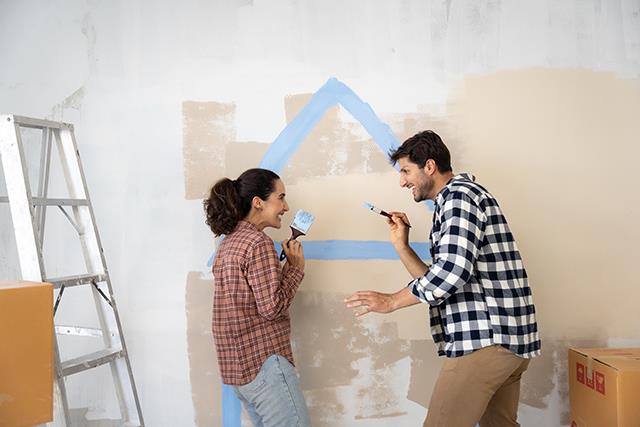Everyone always claims that painting a home is the most affordable way to give it a new look. These same people definitely haven't included the cost of tools, materials and supplies that are required for this project. At the end of the day, painting a room or a home can work out as an expensive exercise - unless you look for ways to save money.

READ: How to disguise your walls using paint
If you have finally decided that your home interior is well overdue for a makeover and have carefully selected the colours you want to use, it's time to put a plan into action and buy everything needed to complete the job.
We have put together some easy ways to help you save money when you decide it's time to paint the interior of your home:
1. Check the expiration date
Keeping a few small pots of paint is great for the occasional touch-ups that need to be done from time to time, but it doesn't always work out that way. Once paint has been applied to walls it starts to be affected by the environment. Sunlight will eventually cause the paint to fade, air quality may also cause the colour to darken, especially if you are a smoker, and daily wear will take its toll.
When you think about conditions that affect paint colour, those little stand-by paint pots are already useless, since they are the colour that was originally applied and that has been kept stashed away in a bottle. As soon as you try to apply to walls you will see a distinct difference between the old and new paint.
If your walls are in need of a desperate makeover, it is going to be far better to buy new paint rather than use paint that has expired or been kept in case of any touch-ups. Another fact to note is that paint has an expiration date, and tends to get smelly with age. If you can't check the expiry date, smell the paint.
2. Calculate how much paint you need
One big way to save money when painting your home’s interior is to make sure you have the right quantity of paint. It is a good idea to have a bit of paint left over for touch-ups and final touches, but you can usually obtain this by cleaning out the paint can. It isn't necessary to buy a whole can, which will eventually expire or be useless.
Most paint cans will have the coverage for that particular paint shown on the can. If it doesn't appear on the paint can, you can use a paint calculator to work out how much paint you will need. By calculating the total quantity of paint required to complete the job, you can save a bit of money by not buying too much paint.
It also pays to only use quality paint brands for painting the interior of a home. Cheaper paints may not offer the same coverage, or hold their colour, or may even require a primer to be applied before applying the paint colour. You ideally want a paint that has a built-in primer, has a guarantee on colour fastness, and is washable.
3. Carefully plan your colour palette
Did you know that selecting standard paint colours for a particular paintjob will save you money as well? If you need to have colours specially mixed, suppliers charge extra for the mixing. We understand that you don't necessarily want to paint every room in a home the same colour, but choosing standard colours will not only give you a cohesive flow through living spaces, it will also ultimately save you money by not having additional colours specially mixed.
4. Look after your tools and materials
Over and above the expense of paint is that of your tools and materials needed for the task. Consider that you will need quality paintbrushes, paint rollers, paint trays, and possibly other tools and materials as well, depending on what needs to be done.
Nothing is cheap these days, and even quality paintbrushes can cost a small fortune, so it pays to look after these so that you can use them again and again. Condition paintbrushes by lightly wetting them beforehand, so that they don't absorb as much paint and are easier to clean.
Decant your paint into a paint tray as this not only ensures that the can of paint won't dry out, but you only dispense as much paint as you can use in a specific time. This also reduces wastage and keeps the paint fresh.
Finally
With these four tips you will definitely keep down the costs on your next painting project and save money on decorating your home.
Try these tips for transforming your home with paint :
1. Use the colour wheel - it helps in matching and complementing your chosen finishes, curtains, couches and furniture.
2. Consider the psychology of colour - it can be used to affect moods in such a way that you can alter the general feeling in a room simply by painting walls in a specific colour.
3. Focus on room orientation - Light affects the appearance of paint colour - so always check your paint under both natural and artificial light sources.
4. Try before you buy - If you want to test colours in action it is recommended to sampling before buying your paint. Buy a sample pot of paint, and test it on a piece of wood or drywall. Hold them up to your flooring, your tile, and other permanent fixtures to see how they’ll compare.
Source : Home-Dzine
Want all the latest property news and curated hot property listings sent directly to your inbox? Register for Property24’s Hot Properties, Lifestyle and Weekly Property Trends newsletters or follow us on Twitter, Instagram or Facebook.








